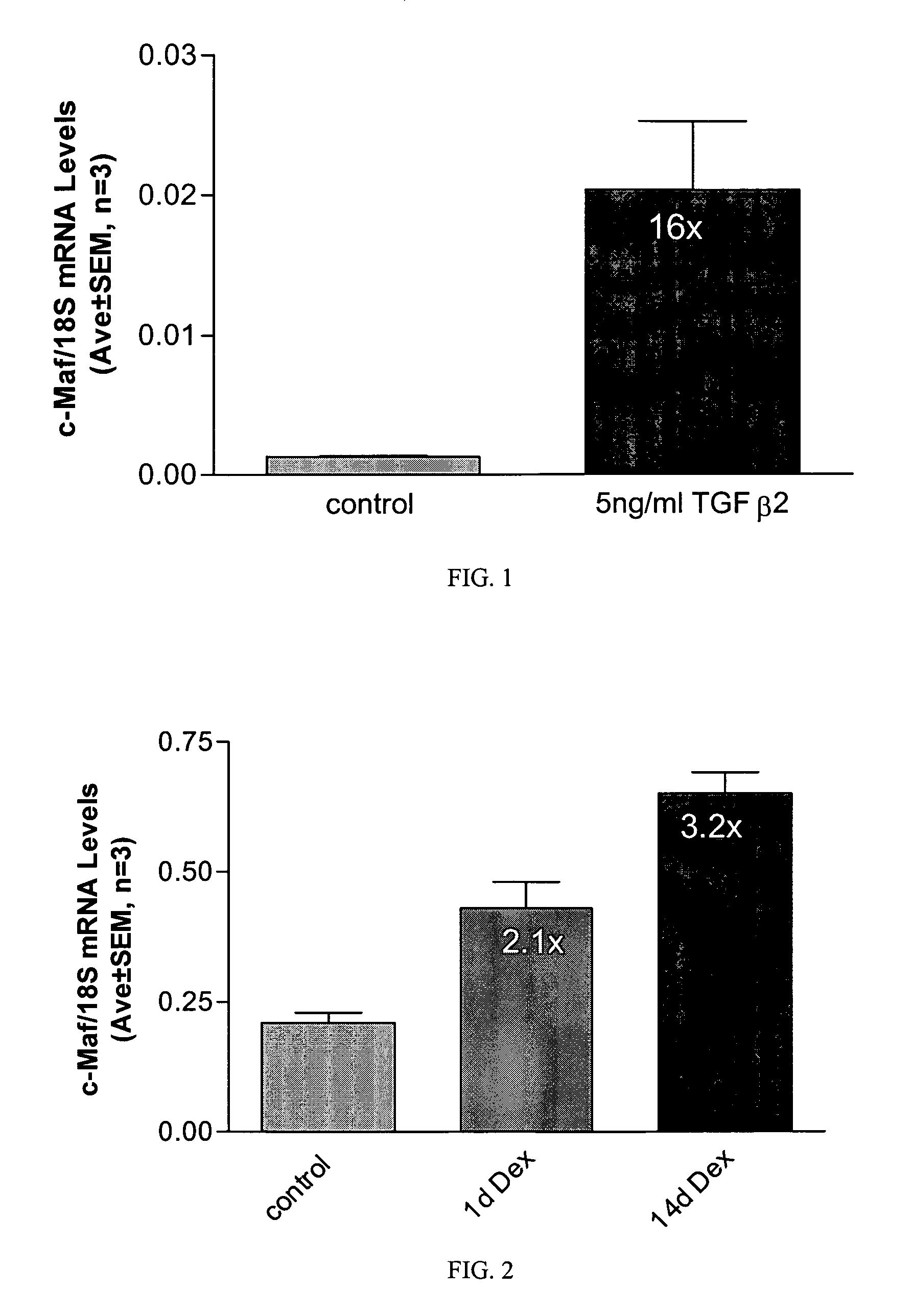Short form c-Maf transcription factor antagonists for treatment of glaucoma
a transcription factor and c-maf technology, applied in the field of c-maf transcription factor antagonists for treatment of glaucoma, can solve the problems of progressive visual loss and blindness, loss of retinal ganglion cells and axons, abnormally high resistance to fluid drainage from the eye,
- Summary
- Abstract
- Description
- Claims
- Application Information
AI Technical Summary
Benefits of technology
Problems solved by technology
Method used
Image
Examples
example 1
RNA Isolation from Human Trabecular Meshwork Tissue and Cells
[0037] Human trabecular meshwork (TM) cells were derived from donor eyes (Central Florida Lions Eye and Tissue Bank, Tampa, Fla.) and cultured as previously described (Steely, et al. (1992), Invest Ophthalmol Vis Sci 33(7): 2242-50; Wilson, et al. (1993), Curr Eye Res 12(9): 783-93; Clark, et al. (1994), Invest Ophthalmol Vis Sci 35(1): 281-94.; Dickerson, et al. (1998), Exp Eye Res 66(6): 731-8; Wang, et al. (2001), Mol Vis 7: 89-94). TM cells were derived from pools of four each of either normal or glaucoma cell lines. Total RNA was isolated from TM cells from each pool using TRIZOL® reagent according to the manufacturer's instructions (Invitrogen, Carlsbad, Calif.).
example 2
Affymetrix GeneChip Analysis
[0038] Reverse transcription, second-strand cDNA synthesis and biotin-labeling of amplified RNA were carried out according to standard Affymetrix protocols. Human genome U133A and U133B GENECHIPS® (Affymetrix, Santa Clara, Calif.) were hybridized, washed and scanned according to standard Affymetrix protocols. Hybridized GENECHIP® arrays were scanned with a GENEARRAY® scanner (Agilent Technologies, Palo Alto, Calif.). Raw data were collected and analyzed using Affymetrix Microarray Suite software.
[0039] Filtering of microarray data was done using GENESPRING® software (Silicon Genetics, Redwood City, Calif.). For each experiment, data were normalized per chip by dividing each measurement by the 50th percentile of all signal intensity measurements for that chip. The expression ratio for each gene was calculated by dividing the normalized signal per gene in the treated or diseased sample by the median for that gene in the control sample for each experiment....
example 3
Quantitative PCR
[0040] First strand cDNA was generated from 1 μg of total RNA using random hexamers and TAQMAN® Reverse Transcription reagents according to the manufacturer's instructions (Applied Biosystems, Foster City, Calif.). The 100 μl reaction was subsequently diluted 20-fold to achieve an effective cDNA concentration of 0.5 ng / μl.
[0041] Measurement of short form c-Maf gene expression was performed by quantitative real-time RT-PCR (QPCR) using an ABI PRISM® 7700 Sequence Detection System (Applied Biosystems) essentially as described Shepard, et al. (2001) Invest Ophthalmol Vis Sci 42(13): 3173-81. Primers for short form-specific c-Maf amplification (Genbank accession #AF055376) were designed using PRIMER EXPRESS® software (Applied Biosystems). Forward and reverse primer sequences were TTGGGACTGAATTGCACTAAGATATAA, SEQ ID NO:1, (nucleotides 3773-3799) and GCGTTCTAAACAGTTTTGCAATTTT, SEQ ID NO:2, (nucleotides 3823-3847), and the minor groove binding probe sequence was CTGCAAGCA...
PUM
| Property | Measurement | Unit |
|---|---|---|
| concentration | aaaaa | aaaaa |
| volume | aaaaa | aaaaa |
| open angle | aaaaa | aaaaa |
Abstract
Description
Claims
Application Information
 Login to View More
Login to View More - R&D
- Intellectual Property
- Life Sciences
- Materials
- Tech Scout
- Unparalleled Data Quality
- Higher Quality Content
- 60% Fewer Hallucinations
Browse by: Latest US Patents, China's latest patents, Technical Efficacy Thesaurus, Application Domain, Technology Topic, Popular Technical Reports.
© 2025 PatSnap. All rights reserved.Legal|Privacy policy|Modern Slavery Act Transparency Statement|Sitemap|About US| Contact US: help@patsnap.com



